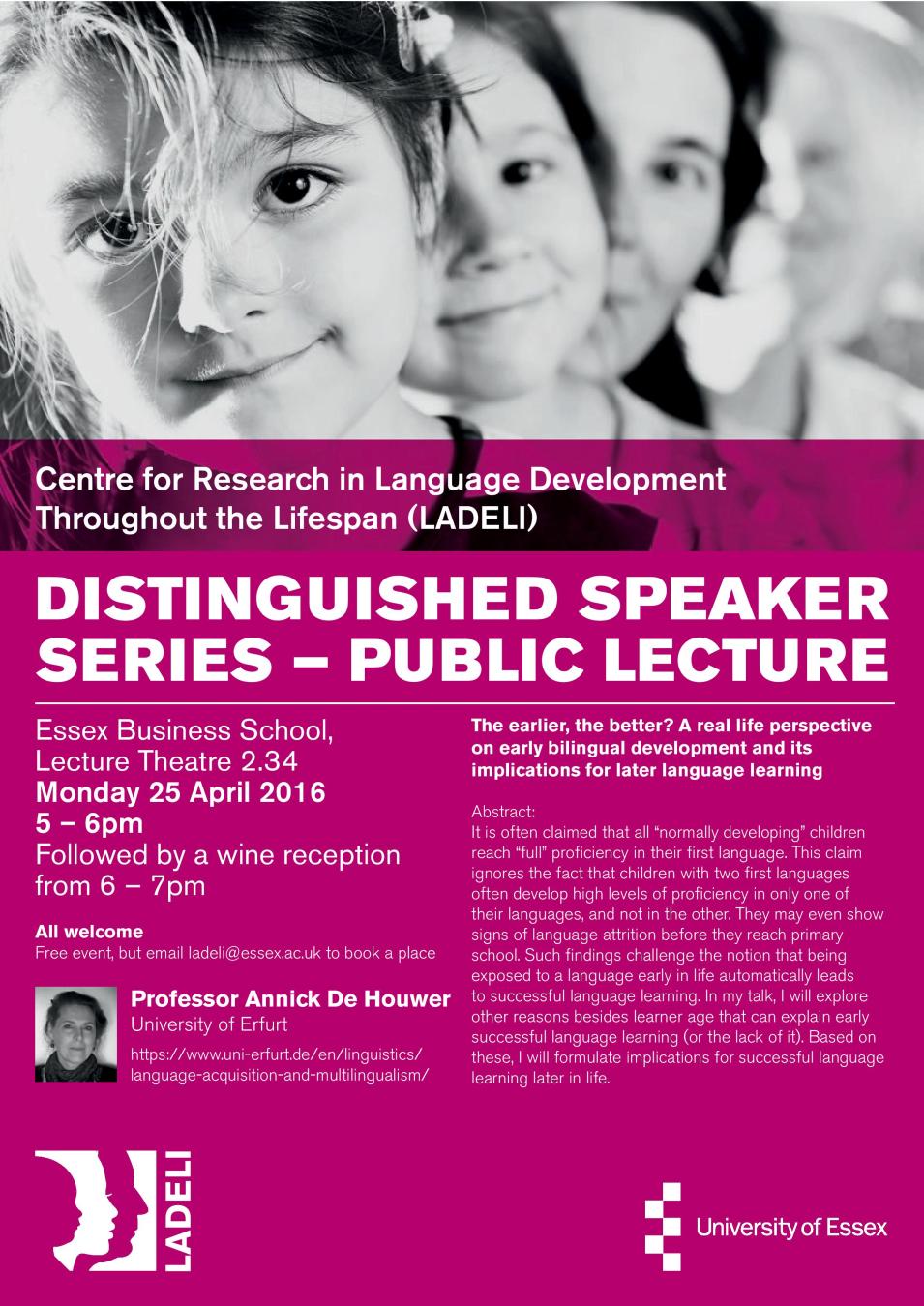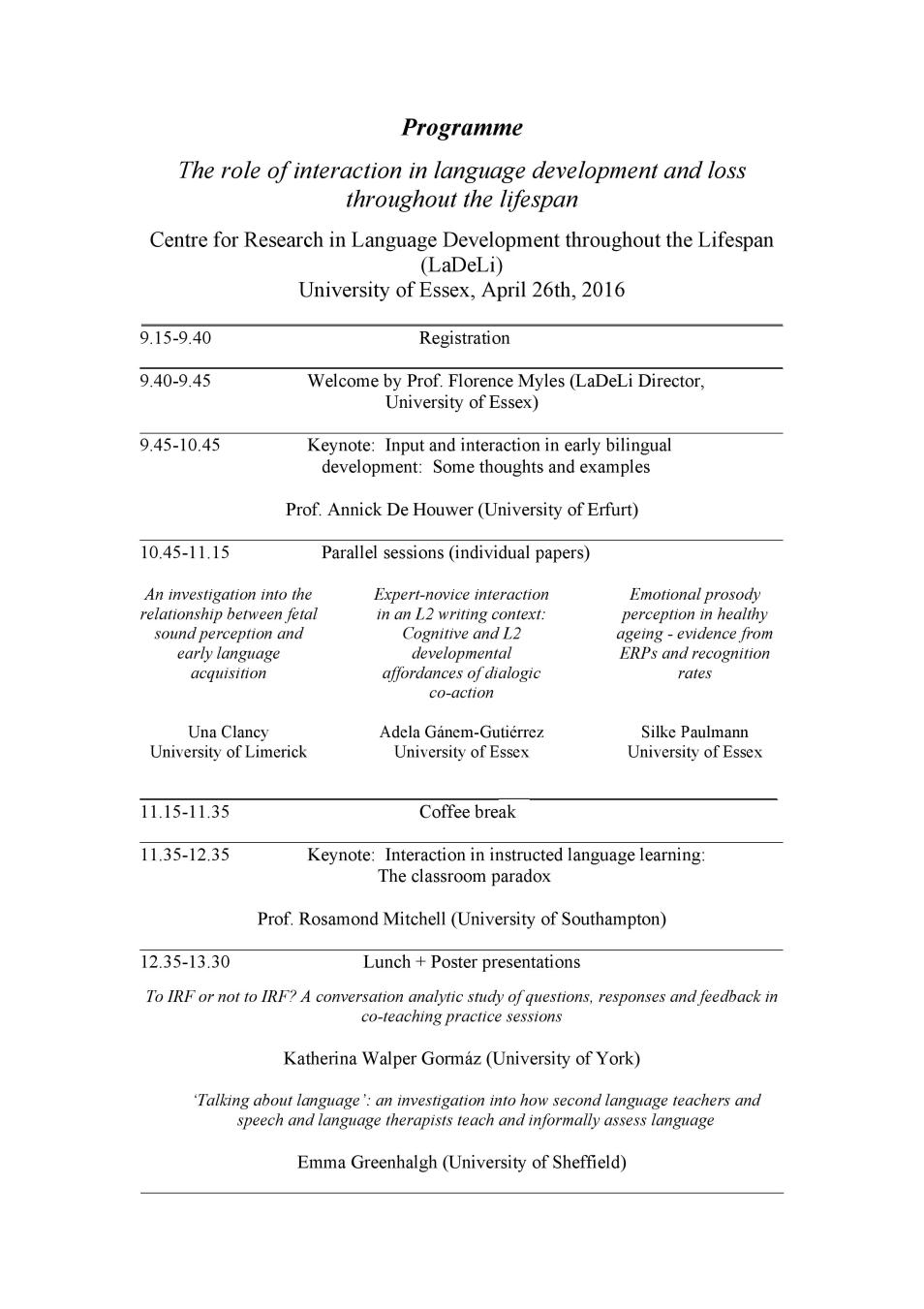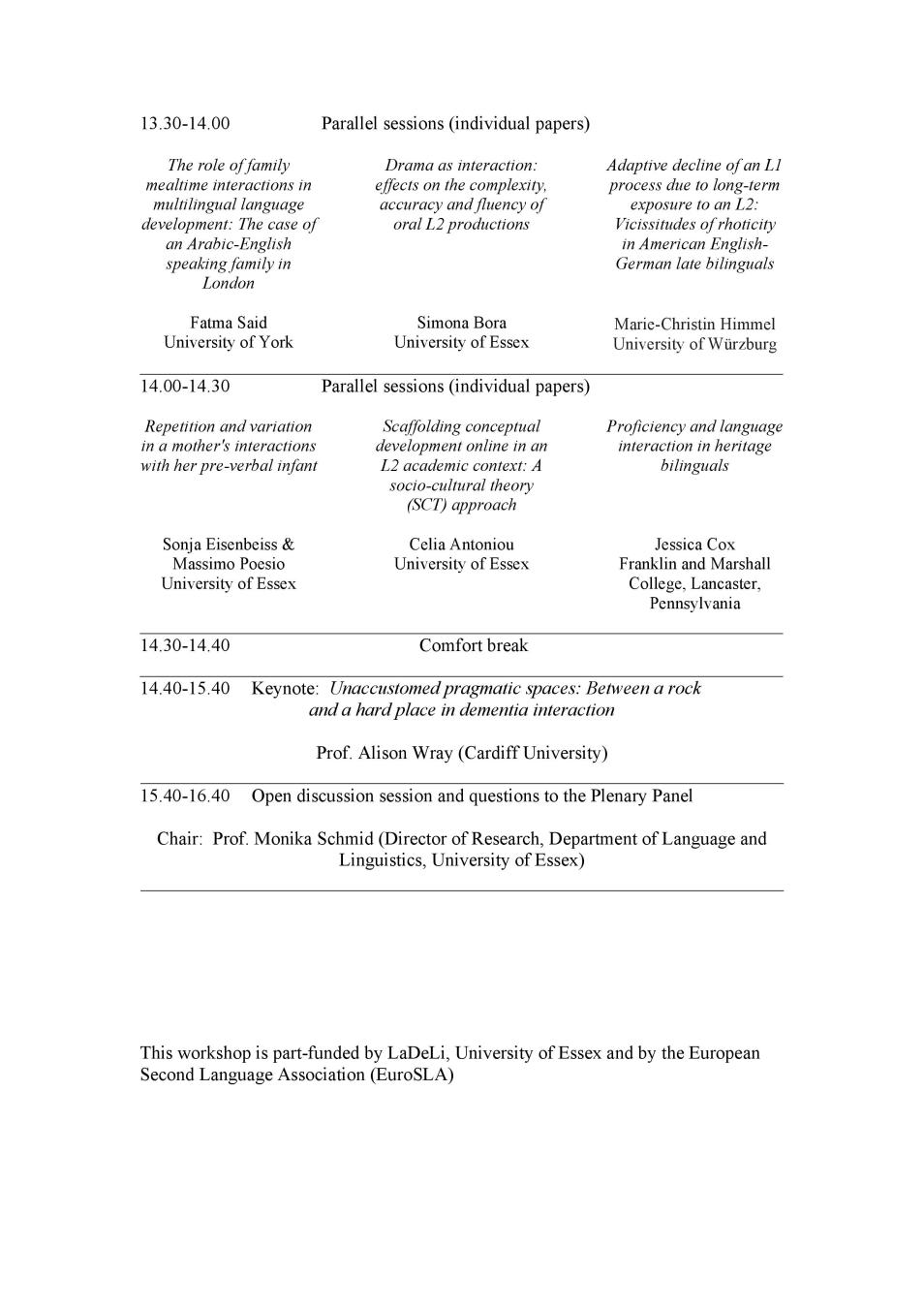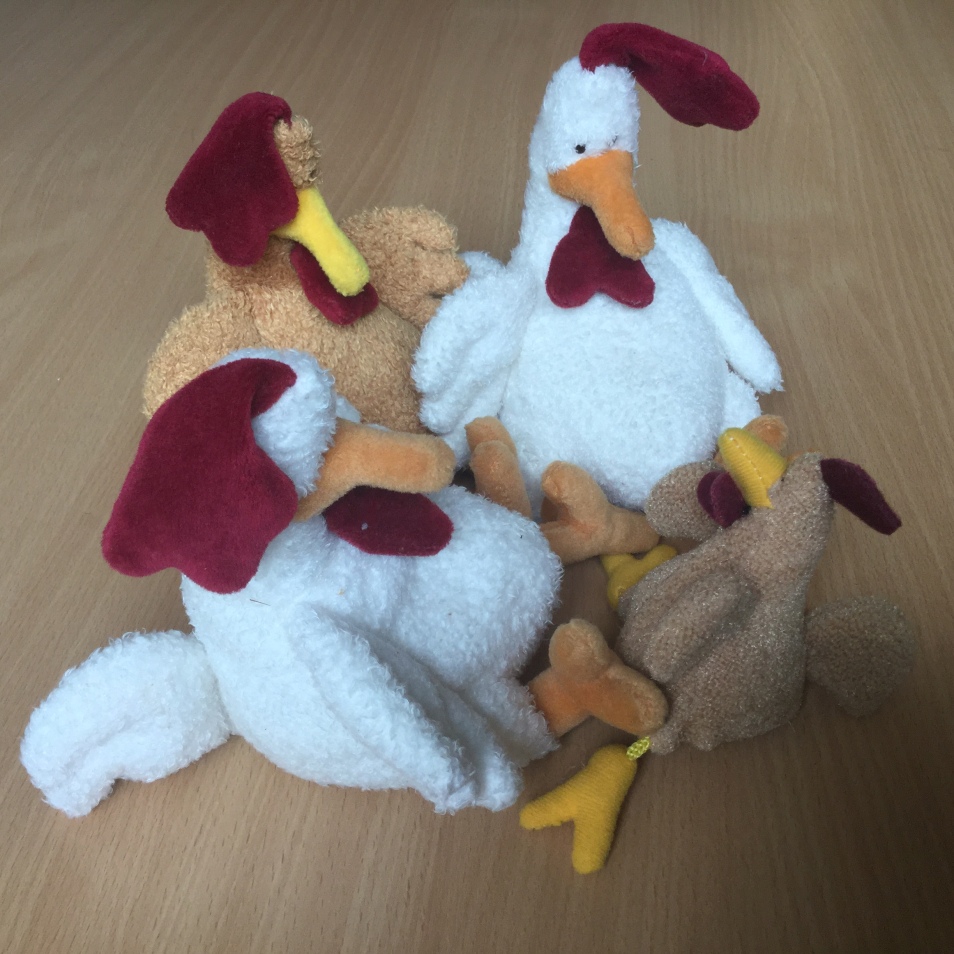Below you can find a list of talks and poster presentations from the 16th Boston Conference on (BUCLD 16). In order to make it easier to find presentations with a strong focus on child-directed speech, I have highlighted them in the copy of the conference schedule below by adding a hashtag symbol that you can search for.
Sonja
P.S. I have moved to Cologne now and I am currently teaching at the University of Cologne and working on my language games.
| 9:00 |
#Nine-month-old infants’ neural oscillatory entrainment to sung nursery rhymes exceeds their parents’
V. Leong, E. Byrne, K. Clackson, S. Georgieva, S. Wass |
#Deafness doesn’t impair executive function, but language deprivation might: Parent-report evidence from deaf native signers, deaf non-signers, and hearing children.
M. Hall, I. Eigsti, H. Bortfeld, D. Lillo-Martin |
Now you hear it, now you don’t: Number mismatch in the comprehension of relative clauses in French
A. Bentea, S. Durrleman |
| 9:30 |
#Infants use prosody for syntactic analysis and grammatical categorization
S. Massicotte-Laforge, R. Shi |
#Homesign Contact and Conventionalization of a Lexicon
L. Horton, S. Goldin-Meadow, D. Brentari |
The Acquisition of Ergativity in Samoan
G. Muagututia, K. Deen, W. O’Grady |
| 10:00 |
#Frequent Frames in Maximally Diverse Languages
S. Moran, D. Blasi, S. Stoll |
American Sign Language Vocabulary Acquisition by Native Deaf Signers
N. Caselli, J. Pyers |
Effects of pronoun referentiality on children’s relative clause processing in Hebrew
Y. Haendler, F. Adani |
| 11:00 |
Cross-linguistic influence in bilingual processing: An ERP study. G. Martohardjono, I. Phillips, C. Madsen II, R. Otheguy, V. Shafer, R. Schwartz. |
Fast mapping word meanings across trials: young children forget all but their first guess.
J. de Villiers, A. Pace, M. Klein, A. Aravind, R. Golinkoff, K. Hirsh-Pasek, M. Wilson |
#Children use syntax of complements to determine meanings of novel attitude verbs
J. Lidz, R. Dudley, V. Hacquard |
| 11:30 |
Acquisition and processing of mass nouns in L2-English: evidence for the role of atomicity
S. Choi, T. Ionin |
#The natural visual statistics of objects matter in statistical word-referent learning
E. Clerkin, L. Smith, C. Yu |
Factivity is acquired gradually over the preschool years
V. Hacquard, R. Dudley, C. Baron, J. Lidz |
| 12:00 |
The integration of linguistic and non-linguistic information in L2 sentence processing
H. Ahn |
The role of temporal dynamics of reference in early word learning
L. Pozzan, T. Dawson, L. Gleitman, J. Trueswell |
Factivity and At-Issueness in the Acquisition of Forget and Remember
A. Aravind, M. Hackl |
| 2:00 |
#English Article Use in Bimodal Bilingual Children with Cochlear Implants:Effects of Language Transfer and Early Language Exposure
C. Goodwin, K. Davidson, D. Lillo-Martin |
#Structural Alignment Facilitates Spontaneous Adjective Learning in Preschoolers
R. Shao, D. Gentner |
The Unmarkedness of Plural: Crosslinguistic Data
K. Yatsushiro, U. Sauerland, A. Alexiadou |
| 2:30 |
Processing of which-questions by children with normal hearing and children with a cochlear implant
A. Schouwenaars, E. Ruigendijk, P. Hendriks, M. Finke |
The Blickish Blob: Object Categories Pose an Obstacle to Adjective Learning
S. LaTourrette, S. Waxman |
The Syntax and Semantics of Adjectival Distribution in Spanish-Polish Bilinguals
T. Judy |
| 4:15 |
Second Language Processing Efficiency: Experience and Cognitive Effects on L2 Morphosyntactic Integration and Anticipation
C. Marull |
Blind speakers show language-specific patterns in co-speech but not silent gesture
S. Ozcaliskan, S. Goldin-Meadow |
On the Nature of the Syntactic Condition on Ellipsis Sites: A View from Child English
K. Sugisaki, H. Kurokami |
| 4:45 |
#Perceptual salience matters for morphosyntactic processing in 9-11-year-olds
S. Dube, C. Kung, K. Demuth |
Does comprehension of gesture show a pattern similar to its production in verbal children with autism?
N. Dimitrova, S. Ozcaliskan, L. Adamson |
V-stranding VP-ellipsis in child Japanese
Y. Fujiwara |
| 5:15 |
Acquiring morphological paradigms in early infancy
J. Raymond, R. Shi, E. Santos |
Universal and language-specific aspects in spatial language development: Revisiting the topological-projective asymmetry
M. Johanson, M. Grigoroglou, A. Papafragou |
The Bottleneck Hypothesis in L2 acquisition: Norwegian L1 speakers’ knowledge of syntax and morphology in English L2
I. Jensen, R. Slabakova, M. Westergaard |
| 9:00 |
Contextual factors in children’s computation of telicity
C. Anderson |
Accessibility differences during production drive semantic (over)-extension
Z. Harmon, V. Kapatsinski |
Similarity-based interference in the acquisition of adjunct control
J. Gerard, J. Lidz, S. Zuckerman, M. Pinto |
| 9:30 |
Early knowledge of the interaction between aspect and quantification: Evidence from child Cantonese
M. Lei, T. Lee |
Children’s use of polysemy to structure new noun categories
M. Srinivasan, C. Berner, H. Rabagliati |
Prepositional object gap production primes active gap filling in 5-year-olds
E. Atkinson, A. Omaki |
| 10:00 |
A study on bilingual children’s semantic-pragmatic comprehension of quantifiers
H. Alatawi |
Modeling the Semantic Networks of School-age Children with Specific Language Impairment and their Typical Peers
P. Brooks, J. Maouene, K. Sailor, L. Seiger-Gardner |
Object clitics in the narratives of high-functioning children with autism
A. Terzi, A. Zafeiri, T. Marinis, K. Francis |
|
Session A (Metcalf Small) |
Session B (Conference Auditorium) |
Session C (Terrace Lounge) |
| 11:00 |
Lexical and syntactic effects on auxiliary selection: Evidence from Child French
V. Boyce, A. Aravind, M. Hackl |
#Gender Differences in Lexical Input and Acquisition
M. Braginsky, S. Meylan, M. Frank |
#Modeling phonetic category learning from natural acoustic data
S. Antetomaso, K. Miyazawa, N. Feldman, M. Elsner, K. Hitczenko, R. Mazuka |
| 11:30 |
#L1 acquisition of thematic role assignment in Tagalog: Word-order-based strategies vs. morphosyntactic cues
R. Garcia, J. Dery, J. Roeser, B. Hoehle |
Children’s status and growth in word types at 20 months predicts age of onset of complex syntax
C. Silvey, Ö. Demir-Lira, S. Goldin-Meadow |
#Development of acoustic cue weighting in 3- and 5-year-old children: Evidence from the Albanian lateral contrast
D. Müller, E. Kapia |
| 12:30 |
#Lunch symposium: Beyond brilliant babies and rapid learning in lexical development: The long and short of language acquisition
Sarah C. Creel (University of California, San Diego)
Larissa Samuelson (University of East Anglia)
Bob McMurray (University of Iowa) |
| 2:15 |
#Mira el Froggie: Language Mixing in Mother-Child Book-Sharing Interactions Among Spanish-speaking Families
A. Weisleder, C. Cates, C. Canfield, A. Seery, A. Mendelsohn |
#What do we learn from distributional learning?
P. Olejarczuk, V. Kapatsinski |
Past tense and plural formation in Welsh-English bilingual children with and without SLI
V. Chondrogianni, N. John |
| 2:45 |
Math Talk in Low Socioeconomic Status Families: An Intervention
E. Graf, S. He, K. Leffel, S. Elizabeth, D. Suskind |
#The impact of phonological knowledge on statistical learning
A. Black, C. Hudson Kam |
Delay or deviance: old question – new evidence from bilingual children with Specific Language Impairment (SLI)
N. Meir, S. Armon-Lotem |
|
Session A (Metcalf Small) |
Session B (Conference Auditorium) |
Session C (Terrace Lounge) |
| 4:30 |
#Testing the Bootstrapping Hypothesis of Infant-Directed Vocabulary: A Longitudinal Individual-Difference Analysis
M. Ota, B. Skarabela, N. Davies-Jenkins, J. Fazekas |
Cognitive-Control Effects on the Kindergarten Path: Separating Correlation from Causation
Y. Huang, N. Hsu, J. Gerard, A. Kowalski, J. Novick |
The development of onset clusters in young children’s speech
C. Levelt, M. Gulian |
| 4:45 |
‘What does the cow say?’ An analysis of onomatopoeia in early interactions
C. Laing |
Inhibitory control is a rate-limiting factor to preschoolers’ use of irregular inflection
A. Yuile, M. Sabbagh |
What’s a foo? Toddlers are not tolerant of other children’s mispronunciations
D. Bernier, K. White |
| 5:45 |
Plenary address
Angela Friederici (Max Planck Institute for Human Cognitive and Brain Sciences) |
SUNDAY, NOVEMBER 6, 2016
|
Session A (Metcalf Small) |
Session B (Conference Auditorium) |
Session C (Terrace Lounge) |
| 9:00 |
Development of a Collective-Distributive Pragmatic Scale
R. Padilla-Reyes, J. Grinstead, M. Nieves Rivera |
Lexical processing efficiency in preschool children: Influences of speech perception and inhibitory control
T. Mahr, J. Edwards |
Control, Raising, and the Problem of Generalization
A. Irani, C. Yang |
| 9:30 |
Some pieces are missing: scalar implicatures in children
S. Eiteljoerge, N. Pouscoulous, E. Lieven |
Flexibility in nonverbal predictions supports language learning in infancy
T. Reuter, C. Lew-Williams |
Topicalization from adjuncts in English vs. Chinese vs. Chinese-English Interlanguage
F. Zenker, B. Schwartz |
| 10:00 |
Children’s understanding of distributivity and adjectives of comparison
A. De Koster, J. Dotlacil, J. Spenader |
Understanding the “word gap”: Cognitive control and processing effects
E. Hollister, Y. Huang |
What cross-linguistic acquisition differences can tell us about invisible syntax: The case of Spanish ‘parecer’
V. Mateu |
| 11:00 |
Closing Symposium: How language learners shape languages
Jennifer Culbertson (University of Edinburgh):
A bias for simpler grammars shapes language in complex ways
Masha Fedzechkina (University of Arizona):
Processing and communication shape language learning and structure
Kenny Smith (University of Edinburgh):
How learning and transmission interact to shape language structure |
Alternates
#F. Bulgarelli, V. Benitez, J. Saffran, K. Byers-Heinlein, D. Weiss: Statistical learning of multiple structures by 8-month-old infants
- Butler: The acquisition of number concepts and numerical language in Yucatec Maya
#M. Casillas, P. Brown, S. Levinson: Age and turn type in Mayan children’s predictions about conversational turn-taking
- Choi, H. Demirdache: Intervention Effects in Korean: Experimental L1 Evidence
- Fetters, J. Lidz: Early knowledge of relative clause islands and island repair
- Kapatsinski: Learning rules, templates and schemas in parallel
- Klassen, A. Tremblay, M. Wagner, H. Goad: Prominence Shifts in Second Language English and Spanish: Learning versus Unlearning
- Martohardjono, I. Phillips, C. Madsen II, R. Otheguy, V. Shafer, R. Schwartz: Cross-linguistic influence in bilingual processing: An ERP study
#C. Potter, J. Saffran: Variable experience improves infants’ recognition of words spoken in an unfamiliar accent
#M. Valleau, S. Arunachalam: The effects of linguistic context on visual attention while learning novel verbs
#H. Wang, T. Mintz: Statistical Learning Requires a Two-Step Process
- Yin: The Acquisition of Number Agreement in What BE these/those Sentences in English
Posters
- Abed Ibrahim, C. Hamann: Bilingual Arabic-German and Turkish-German Children with and without Specific Language Impairment: Comparing Performance in Sentence and Nonword Repetition Tasks
- Al-Thubaiti: Non-native characteristics in the ultimate grammars of highly proficient child L2 starters of English
- Altan, H. Annette, U. Kaya: Discrimination of vowel-harmonic vs vowel-disharmonic words by monolingual Turkish infants in the first year of life
- Austin, K. Syrett, L. Sanchez, A. Lingwall, S. Perez-Cortes: Morphological Development and the Acquisition of Quantifiers in Child L2 Spanish
- Berends, A. Hulk, P. Sleeman, J. Schaeffer: Ultimate Attainment in Second Language Acquisition: The Dutch quantitative pronoun ER
- Bergelson, T. Eagle: Links between talking, walking, and pointing: analysis of parental report & observation
- Bláhová, F. Smolík: Personal pronouns and verb person conjugation: The use of person reference and mental state language is related in 30-month-olds, above and beyond general language
#F. Bulgarelli, V. Benitez, J. Saffran, K. Byers-Heinlein, D. Weiss: Statistical learning of multiple structures by 8-month-old infants
- Chen, V. Valian, M. Chodrow: The Same Factors Influence Subject Use in Children and Adults
- Choi, H. Demirdache: Intervention Effects in Korean: Experimental L1 Evidence
- Conwell: Pronouns facilitate comprehension of double object, but not prepositional, datives
- De Cat, L. Serratrice: The Bilingual Profile Index: a new, gradient measure of language experience
- Dekydtspotter, C. Gilbert, K. Miller, M. Iverson, T. Leal, I. Innis: ERP Correlates of Cyclic Computations: Anaphora in Native and L2 French
- Eigsti, J. Mayo, E. Simmons, J. Magnuson: Qualitative versus quantitative measurement of speech in autism: Beyond the Good and the Beautiful
- Family, E. Dovenberg, K. Katsika, M. Naumovets, L. Fernandez, M. Iraola Azpiroz, S. Allen: Cross-linguistic influence in incremental parsing of temporary syntactic ambiguities in L2 English
- Fetters, J. Lidz: Early knowledge of relative clause islands and island repair
- Gambi, F. Gorrie, M. Pickering, H. Rabagliati: Do young children predict the forms of words?
- Gao, W. Ma, P. Zhou: A reduced sensitivity to tones in young tone learners
- Garcia, H. Goad, N. Guzzo: L2 Acquisition of High Vowel Deletion in Quebec French
- Gervain, J. Werker, A. Black, M. Geffen: The neural correlates of processing scale-invariant environmental sounds in infancy
- Goksun, N. George, H. Kartalkanat, B. Uzundag, E. Turan: Expressions of complex causal relations in speech and gesture
- Gordon, M. Kibbe: Young children’s learning of gestural and verbal labels for novel objects: The role of meaningfulness
- Grüter, A. Takeda, H. Rohde, A. Schafer: L2 Listeners Show Anticipatory Looks to Upcoming Discourse Referents
- Hartshorne, J. Tenenbaum, S. Pinker: A critical period for second language acquisition: Evidence from 669,498 English speakers
- Kamari, S. Raghibdoust: Dyslexic Children and Reading Persian Orthography
- Kocab, A. Senghas, J. Snedeker: Recursion in Nicaraguan Sign Language
- Lacerda: Information Structure in child English: Contrastive topicalization and the dative alternation
- Lau: AI > IA: The Effect of Animacy in the Production of Cantonese Relative Clauses
- Lima, P. Li, J. Snedeker: Counting on a count list: what Yudja tells us about number word acquisition
- Manetti, A. Belletti: The production of Clitic Left dislocations by Italian-speaking children and the role of intervention
- Martohardjono, I. Phillips, C. Madsen II, R. Otheguy, V. Shafer, R. Schwartz: Cross-linguistic influence in bilingual processing: An ERP study
- Messenger, S. Hardy: Exploring the lexical boost to syntactic priming in children and adults.
- Miller, C. Renaud: Anticipation in a second language: Examining lexical versus morphological cues in French future tense
- Myers, D. Skordos, D. Barner: Reasoning with alternatives in logical inference
- Nguyen, W. Snyder: The (Non)-Effects of Pragmatics on Children’s Passives
- Patience: The perception of stop-approximant contrasts by L1 English-L2 Spanish speakers
#L. Perry, M. Perlman, B. Winter, G. Lupyan, D. Massaro: The role of iconicity in child-directed speech
#R. Peters, T. Grüter, A. Borovsky: Language experience and skill alters the dynamics of lexical prediction in sentence processing
- Petroj: Article distribution in child bimodal bilingual whispered speech
#C. Potter, J. Saffran: Variable experience improves infants’ recognition of words spoken in an unfamiliar accent
- Ramirez, C. Echols: Language Activation in Child L2 Learners
#L. Rissman, L. Horton, S. Goldin-Meadow: Event categories in the absence of linguistic input: a cross-cultural study of child homesign
- Royle, D. Valois, L. Fromont, J. Drury: French children’s mastery of definiteness and maximality
- Sauerland, K. Yatsushiro: Conjunctive Disjunctions in Child Language: A New Account
- Schreiner, N. Mani: Successful word learning across different speech registers
- Sequeros-Valle, B. Hoot, J. Cabrelli Amaro: Clitic-doubled Left Dislocation in L2 Spanish – Data from a Speeded Production Task
- Smeets: Ultimate Attainment at the Syntax-Discourse Interface: the acquisition of object movement in Dutch.
- Soja, M. Goodwin, L. Naigles: The Role of Light Verbs in the Mastery of New Tense Forms: A Case Study of One Child with Language Delay
- Sutton: Structure & acquisition of Estonian semantic case
- Tanaka, W. O’Grady, K. Deen, I. Bondoc, J. Soriano: Differential Preferences in the Acquisition of Symmetrical Voice Language
- Terunuma, T. Nakato, M. Isobe, M. Nakajima, R. Okabe, S. Inada, S. Inokuma: Acquisition of recursive possessives and locatives within DPs in Japanese
- Tieu, M. Križ: Connecting the exhaustivity of clefts and the homogeneity of plural definites in acquisition
- Topaloglu, M. Nakipoglu: How Turkish-speaking children interpret pre-verbal sadece ‘only’: the role of prosody and pragmatics
#A. Tsui, M. Berthiaume, L. Erickson, E. Thiessen, C. Fennell: How language background and individuals’ attentional processes contribute to the success of tracking two inputs in a statistical learning task
#M. Valleau, S. Arunachalam: The effects of linguistic context on visual attention while learning novel verbs
#S. van der Feest, C. Blanco, R. Smiljanic: Effects of Speaking Style and Context on Online Word Recognition in Young Children and Adults
- van Hout, M. Arche, H. Demirdache, I. García del Real, A. García Sanz, A. Gavarró, L. Gomez Marzo, S. Hommes, N. Kazanina, J. Liu, O. Lungu, F. Martin, I. Strangmann: Agent Control and the Acquisition of Event Culmination in Basque, Dutch, English, Spanish and Mandarin
- Veenstra, K. Antoniou, N. Katsos, M. Kissine: Resisting attraction: The role of executive control in monolingual and bilingual children
- Wagner, C. Geraci, J. Kuhn, K. Davidson, B. Strickland: Is Telicity in Sign Languages Visible to Children?
- Wakefield, C. Hall, S. Goldin-Meadow: Representational Gesture as a Tool for Promoting Verb Generalization in Young Children
- Yow, X. Li, S. Lam, T. Gliga, K. Kwek, S. Saw, L. Shek, F. Yap, Y. Chong, B. Broekman: Effects of bilingualism on children’s use of social cues in word learning
- Zaretsky: Cross-linguistic Transfer: The Role of L1 Grammatical Morphology in L2 Reading Comprehension Among ELLs From Low SES
#Y. Zhang, C. Yu: Investigating Real-Time Cross-Situational Learning Using Naturalistic Data from the Child’s View
#A. Armstrong, N. Bulkes, D. Tanner: Use of quantificational cues in the processing of English subject-verb agreement by native Chinese speakers
- Bulkes, K. Christianson, D. Tanner: Effects of semantic opacity on prediction during native and nonnative reading
- Butler: The acquisition of number concepts and numerical language in Yucatec Maya
#C. Canfield, A. Weisleder, C. Cates, A. Seery, A. Mendelsohn: Long-Term Impacts of Parenting Stress on Language Development in Low-Income Children
- Casillas, P. Brown, S. Levinson: Age and turn type in Mayan children’s predictions about conversational turn-taking
- Chen, N. Xu Rattanasone, F. Cox, K. Demuth: Australian English-learning 24-Month-Olds (But Not 18-Month-Olds) are Sensitive to Phonemic Vowel Length
- Chen, R. Magid, J. Pyers: The effect of iconicity type on preschoolers’ gesture learning: A role for embodiment?
- Chromá, F. Smolík: Personal pronouns and verb person inflections: relations with grammatical development and early social understanding
#C. Core, D. Martinez-Nadramia, S. Chaturvedi: The role of language experience in nonword repetition tasks in young bilingual Spanish-English speaking children
- Creel: Plausibility constrains accented speech comprehension in monolingual and bilingual children
- Cuza, P. Guijarro-Fuentes: Copula distribution in the Catalan and Spanish grammars of child and adult bilinguals
- Davies, N. Xu Rattanasone, K. Demuth: Children’s Emerging Understanding of the Syllabic Plural Allomorph
- DeAnda, K. Hendrickson, D. Poulin-Dubois, P. Zesiger, M. Friend: Lexical Access in the Second Year: a Cross-linguistic Investigation of Monolingual and Bilingual Vocabulary Development
- Ergin, D. Brentari: Hand shape preferences for nouns and verbs in Central Taurus Sign Language
- Flaherty, D. Hunsicker, S. Goldin-Meadow: The Seeds of Nicaraguan Sign Language are Not Found in Gesture
- Forsythe: Top-down learning in the acquisition of pronouns
- Foushee, F. Xu: Development in Preschooler’s Learning from Naturalistic Overheard Speech
- Getz: Tracking forms within structures: How children learn the wanna facts
- Grigoroglou, A. Papafragou: Informativeness and listeners’ needs in children’s event descriptions
- Grinstead, P. Lintz, A. Pratt, M. Vega-Mendoza, J. De la Mora, M. Cantú-Sánchez, B. Flores-Avalos: Overt Subjects & Interface Deficit in Spanish SLI: A Discriminant Function Analysis
- Hara: Second Language Learners’ Greater Difficulty with Structural Processing Routines over Case Morphology in Processing Japanese Relative Clause Sentences
- Hopp, N. Lemmerth: L2 predictive gender processing: Effects of lexical and syntactic L1-L2 congruency
- Iraola Azpiroz, J. Järvikivi, S. Allen, L. Roberts, P. Schumacher: Resolution preferences in German: interpretative preferences of 6-year-olds
- Kang, B. Lust: Bilingual proficiency influences the relationship between code-switching and task-switching in 8-year-old English-Chinese Singaporean children
- Kapatsinski: Learning rules, templates and schemas in parallel
- Klassen, A. Tremblay, M. Wagner, H. Goad: Prominence Shifts in Second Language English and Spanish: Learning versus Unlearning
- Kremer, B. Hollebrandse, A. van Hout: The Role of Working Memory and Theory of Mind in the Acquisition of Definiteness in Dutch Children
- Lakusta, M. Thothathiri, D. Mendez, M. Marinkovic: Evidence for a Broad Notion of Source in Child Language
#C. Lew-Williams, D. Watson: Acoustic prominence and audience design in child- vs. adult-directed speech
#J. Li, L. liu, J. Snedeker: Whether and Why There Are Cross-cultural Differences in the Acquisition of Reference
#W. Ma, R. Golinkoff: Syntactic Bootstrapping For Form Class Distinction in Mandarin Child-directed Speech
- Mitsugi: Syntactic prediction in L2 comprehension: Evidence from Japanese adverbials
- Noguchi, C. Hudson Kam: Learning of talker-specific phonemic contrasts by adults
- Parish-Morris, M. Santulli, M. Swanson, A. Estes, J. Pandey, R. Schultz, S. Paterson, and the IBIS Network: Individual Growth Trajectories of Typical and Atypical Vocalization from 6 to 24 months
- Puig-Mayenco, D. Miller, J. Rothman: Language Dominance Affects Bilingual Competence and Processing: Evidence from a bidirectional study of Unbalanced Catalan/Spanish Bilinguals
- Requena, M. Dracos, K. Miller: Acquisition of Spanish Mood Selection in Complement Clauses
- Rodina: Understanding the relationship between narrative sample measures and grammaticality in heritage Russian
- Schaeffer, B. Siekman: Are children with High-Functioning Autism better at syntax than typically developing children? The case of Dutch Object Relative Clauses
- Schmitterer, S. Schroeder: The Development of Semantic Relatedness from Preschool to School
- Schuler, C. Yang, E. Newport: Children form productive rules when it is more computationally efficient to do so
- Serratrice, C. De Cat, S. Berends: Inhibitory control, working memory and language experience in the referential choices of monolingual and bilingual children
- Smolík: Are adult age-of-acquisition ratings valid measures of child language? Comparing AoA ratings with word emergence in longitudinal corpora
- Sugawara: Japanese L2 learners of English are sensitive to QUD and prosodic inference
- Sugiura, H. Shimada: Children’s Non-Isomorphic Interpretation in Japanese Conditinals
#H. Wang, T. Mintz: Statistical Learning Requires a Two-Step Process
- Westergaard, M. Anderssen, K. Bentzen, G. Busterud, A. Dahl, J. Didriksen, B. Lundquist: The acquisition of Subject and Object Shift in L2/Ln Norwegian
- Whang, F. Adriaans: Phonotactics and alternations in the acquisition of Japanese high vowel reduction
- White, H. Goad, J. Su, L. Smeets, M. Mortazavinia, G. Garcia, N. Guzzo: Prosodic Effects on Pronoun Interpretation in Italian
- Wojcik, J. Werker: The effect of vocabulary size and language exposure on the emergence of monolingual and bilingual toddlers’ lexical-semantic networks
- Yin: The Acquisition of Number Agreement in What BE these/those Sentences in English
- Yurovsky, N. Burke, A. Woodward, S. Goldin-Meadow: Children’s gestures provide a continuous signal of word knowledge
- Ziegler, J. Snedeker: Structural priming across development: The lexical boost, abstract priming, and task demands
Society for Language Development Symposium
The topic is Timing in Development, and the invited speakers are:
Takao Hensch, Harvard University
Elissa L. Newport, Georgetown University
Barbara Landau, Johns Hopkins University
Information about SLD can be found at their website: http://www.bcs.rochester.edu/sld/symposium.html




